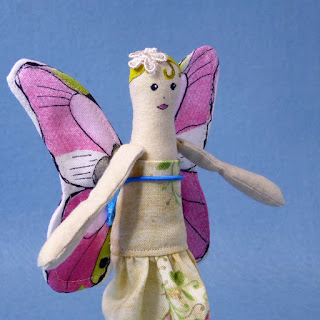I wanted to create a design of a line of really small fabric dolls made in cotton with an aspect of the insect about them. This would combine my love for creating softies as well as bugs. Today I finished this first group of five designs - Butterfly dolls.

They are 14cm tall cotton fabric filled dolls wit removable dresses and wings and painted faces. They are a little bit Art Nouveau in style, a tiny bit Kewpie doll, a teensy bit fairy doll and are rather cute.
The biggest trade-offs were with size over articulation. I went as tiny as I could comfortably sew piees so that they could still be comfortably turned. I was able to make removable dresses and wings for each doll so it alows them to grow into part of a heirloom collection. I found wonderful wooden stands that worked a treat for the dolls as well.
The faces are created by a mixture of painting and then inked in details using fabric safe pens. In the designs of the features and the hair I tried to capture the detail of the wing fabric which is gorgeous. I tried wool hair first but I was not as happy with the result. The painted effect I think echoes the design much better.
I am inspired by this flexible design and want to create over options around other bugs. They photographed well and were fun to pose.






























